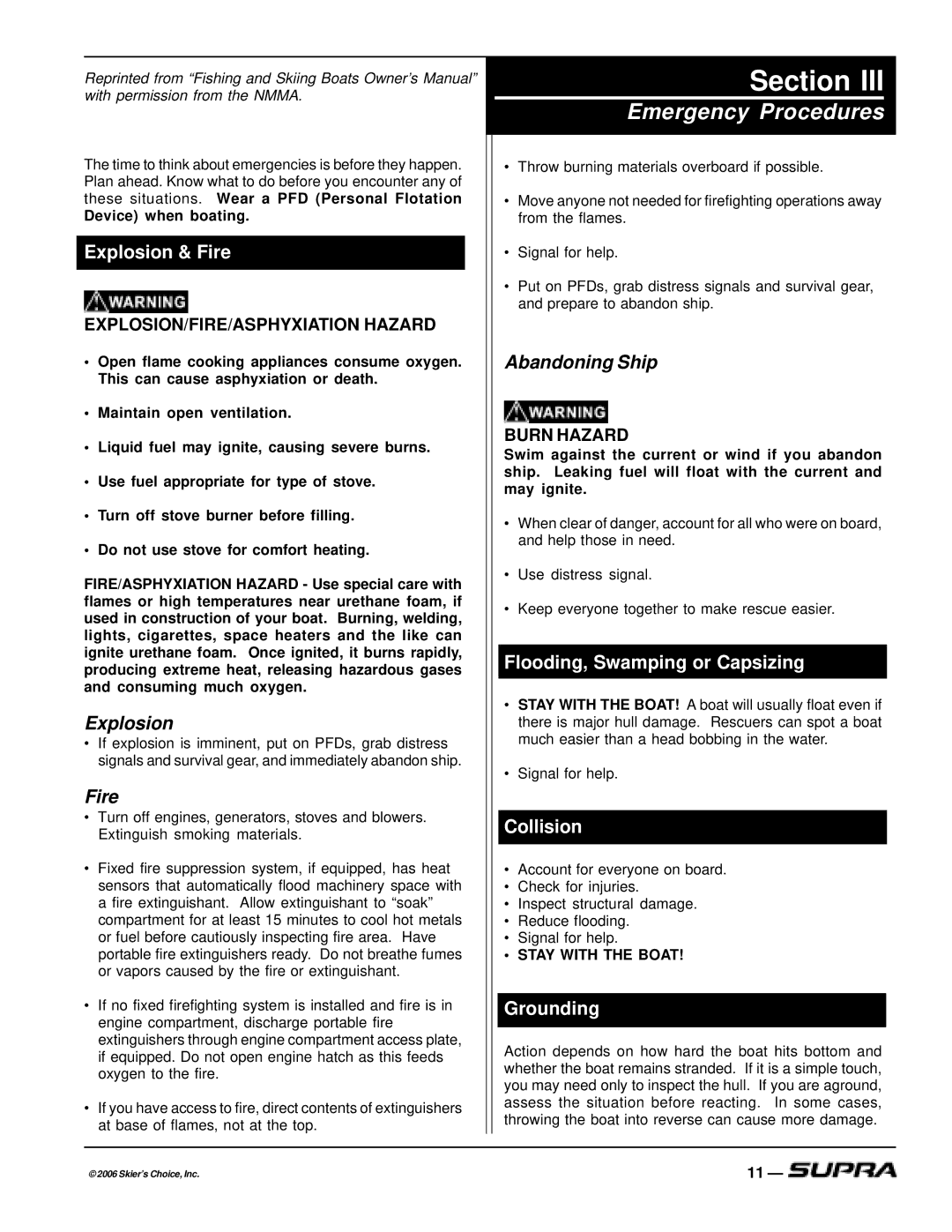
Reprinted from “Fishing and Skiing Boats Owner’s Manual” with permission from the NMMA.
The time to think about emergencies is before they happen. Plan ahead. Know what to do before you encounter any of these situations. Wear a PFD (Personal Flotation
Device) when boating.
Explosion & Fire
EXPLOSION/FIRE/ASPHYXIATION HAZARD
•Open flame cooking appliances consume oxygen. This can cause asphyxiation or death.
•Maintain open ventilation.
•Liquid fuel may ignite, causing severe burns.
•Use fuel appropriate for type of stove.
•Turn off stove burner before filling.
•Do not use stove for comfort heating.
FIRE/ASPHYXIATION HAZARD - Use special care with flames or high temperatures near urethane foam, if used in construction of your boat. Burning, welding, lights, cigarettes, space heaters and the like can ignite urethane foam. Once ignited, it burns rapidly, producing extreme heat, releasing hazardous gases and consuming much oxygen.
Explosion
•If explosion is imminent, put on PFDs, grab distress signals and survival gear, and immediately abandon ship.
Fire
•Turn off engines, generators, stoves and blowers. Extinguish smoking materials.
•Fixed fire suppression system, if equipped, has heat sensors that automatically flood machinery space with a fire extinguishant. Allow extinguishant to “soak” compartment for at least 15 minutes to cool hot metals or fuel before cautiously inspecting fire area. Have portable fire extinguishers ready. Do not breathe fumes or vapors caused by the fire or extinguishant.
•If no fixed firefighting system is installed and fire is in engine compartment, discharge portable fire extinguishers through engine compartment access plate, if equipped. Do not open engine hatch as this feeds oxygen to the fire.
•If you have access to fire, direct contents of extinguishers at base of flames, not at the top.
Section III
Emergency Procedures
•Throw burning materials overboard if possible.
•Move anyone not needed for firefighting operations away from the flames.
•Signal for help.
•Put on PFDs, grab distress signals and survival gear, and prepare to abandon ship.
Abandoning Ship
BURN HAZARD
Swim against the current or wind if you abandon ship. Leaking fuel will float with the current and may ignite.
•When clear of danger, account for all who were on board, and help those in need.
•Use distress signal.
•Keep everyone together to make rescue easier.
Flooding, Swamping or Capsizing
•STAY WITH THE BOAT! A boat will usually float even if there is major hull damage. Rescuers can spot a boat much easier than a head bobbing in the water.
•Signal for help.
Collision
•Account for everyone on board.
•Check for injuries.
•Inspect structural damage.
•Reduce flooding.
•Signal for help.
•STAY WITH THE BOAT!
Grounding
Action depends on how hard the boat hits bottom and whether the boat remains stranded. If it is a simple touch, you may need only to inspect the hull. If you are aground, assess the situation before reacting. In some cases, throwing the boat into reverse can cause more damage.
© 2006 Skier’s Choice, Inc. | 11 — |
